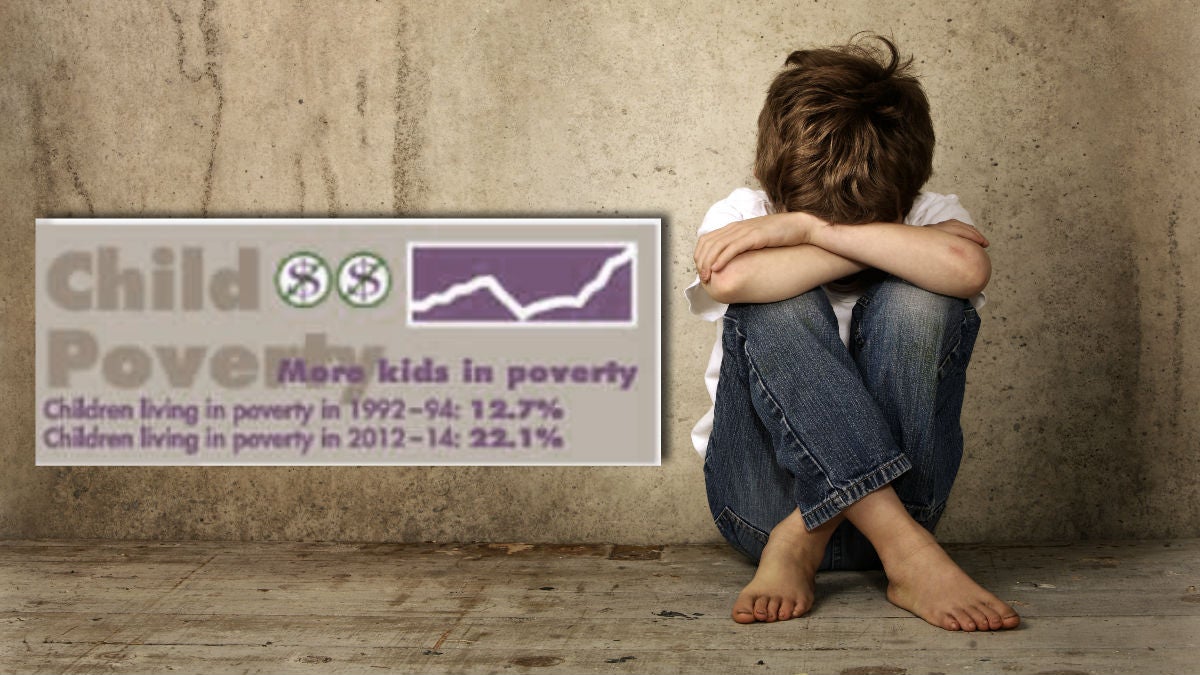Delaware fights childhood poverty as numbers continue to rise
 Child alone image via ShutterStock) " title="child-poverty-169" width="1" height="1"/>
Child alone image via ShutterStock) " title="child-poverty-169" width="1" height="1"/>
(Child alone image via ShutterStock)
Statistics show childhood poverty on the rise in Delaware.
Kiana, a first-time mother, sits in her Wilmington home with her baby boy, her boyfriend and her nurse, Tiffany Hammond.
Hammond asks Kiana questions about her own health, measures her son’s weight, head and height, and listens to his heartbeat.
She offers advice on when it’s okay to give her son cereal, and lectures her on why it’s a bad idea to feed him a Popsicle—something he ate a couple days prior.
Hammond pulls out a large folder, and discusses the topic of the day—healthy sleep—and quizzes Kiana.
“Why is it best for babies to sleep with their parents?”
“It’s dangerous for a baby to sleep in bed with you. Can you think why?”
At the end of the meeting, Hammond discuss Kiana’s goals—to find a part-time job, get a driver’s license and eventually save up money for a car.
“She does help a lot,” Kiana said. “I’m still learning things and that’s why I did the program.”
This is a typical meeting for Children & Families First’s evidence-based home visiting program, one of many in place to reduce poverty in Delaware and prevent its effects on children and the family.
Delaware social workers hope programs like this will help lessen alarming statistics about childhood poverty in the state.
According to a University of Delaware Kids Count conducted report, almost one in five Delaware children, 18 percent, are facing poverty—up from 14 percent in 2008—and more of them are under age 5. In addition, nearly a third of children live in families where no parent has full-time employment, and homeless rates among children continue to rise.
Despite the recovery of the recession, childhood poverty has continued to increase, said Janice Barlow, director of Kids Count Delaware, which is located in the Center for Community Research and Service at the University of Delaware.
She said this is partly due to the lack of quality jobs that became available afterwards.
“We lost a lot of blue collar factory jobs, and during the recovery there has been more service industry, lower paying jobs and jobs that might not carry benefits like healthcare and paid sick leave,” Barlow said.
She also said that many children living in poverty live in one-parent households, limiting the amount of income coming in.
“When we look at numbers of what single parent families earn in a year versus two parent families we see the two-parent families earn double,” Barlow said.
When a family is faced with the stress of poverty it impacts all aspects of their lives, said Leslie Newman, CEO of Children & Families First. While many low-income parents are more than competent at raising their children, they are still faced with issues like choosing between medication and food and finding somewhere to sleep, which means there are more opportunities for neglect, she said.
“If children are living in poverty there are so many things competing for their attention,” Newman said.
“Imagine a child who goes to school hungry or whose parents are involved drugs or housing is not steady, imagine that child going to school in the morning—what are the chances they will be successful?”
Studies have found adults who had traumatizing childhoods, such as being raised by a parent who’s an addict or incarcerated, are more likely to have mental and physical health issues, she said.
“When you experience the trauma it negatively impacts brain development,” Newman said.
Her agency’s evidence-based home visiting program is based around the philosophy that a child’s future is determined before age 2.
As soon as a woman becomes pregnant, a certified nurse will visit her and continue until her child is 2, giving her the necessary tools that will help her child and future generations of the family to come. Social workers call this a two-generational strategy to poverty.
This is one of several programs Children & Families First offers low-income families to help them overcome their situation. Every year, the agency serves about 40,000 individuals.
Each home visit lasts about an hour and is on a weekly or bi-weekly basis depending on the clients’ needs. There are several topics the nurse can talk about with the client, and the nurse educates them on those topics.
“I’m able to build a relationship, and they’re able to trust me and often times they call me before they call their doctor,” Hammond said. “It’s very rewarding. It feels great to know you’re able to make a difference in people’s lives.”
She said the program helps clients become better parents, have a healthier pregnancy and provides the support and confidence they need to accomplish their goals.
“We’re sort of like their cheerleader,” Hammond said.
Kiana was diagnosed with sickle-cell anemia at 7 months old. Her illness has improved over the years, but when she was younger she spent the majority of her days at the hospital, and as an adult her condition has made it difficult for her to work.
Kiana was attending the Harris School of Business, but dropped out when she had the baby. Her boyfriend and father to her son doesn’t work because he was shot and seriously injured two years ago, and is waiting for disability benefits.
Kiana’s doctor told her about the home-visiting program, and she said she thought it would be helpful. Tiffany taught Kiana how to change a diaper, how to swaddle a baby and how to take care of her son’s circumcision.
Not only has Tiffany given her baby advice, but she’s also helped her with her medical concerns, even getting in touch with doctors and her insurance company to make sure she receives her medical equipment and prescriptions.
“Without her…I don’t know,” Kiana said. “She’s done a lot for me.”
Kiana creates a goal every week—and now she wants to stay on top of her school work. The program has encouraged her to enroll in online classes with Ultimate Medical Academy, so she can eventually find work and have a livable wage.
“I know I will,” Kiana said. “I have a son now, and I need to be financially stable with my son.”
Newman said there is no easy solution to childhood poverty, and there needs to be a collaborative effort to address it.
“We need to find jobs for people, to provide training to and to make sure they’re in a job that pays a livable wage,” she said.
“We need to find increased ways to have low-income children have access to high quality child care. We need to continue to find ways to engage families so they can be wonderful parents and that goes across the income spectrum.”
The issue of poverty has also left a surprising number of Delaware’s children homeless. Read more here on Newsworks.org/Delaware.
WHYY is your source for fact-based, in-depth journalism and information. As a nonprofit organization, we rely on financial support from readers like you. Please give today.





